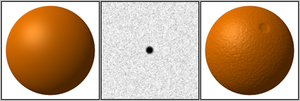2.5D
This article needs additional citations for verification. (June 2023) |
 |
| Part of a series on |
| Video game graphics |
|---|
2.5D (two-and-a-half dimensional) perspective refers to gameplay or movement in a video game or virtual reality environment that is restricted to a two-dimensional (2D) plane with little or no access to a third dimension in a space that otherwise appears to be three-dimensional and is often simulated and rendered in a 3D digital environment.
This is similar but different from pseudo-3D perspective (sometimes called three-quarter view when the environment is portrayed from an angled top-down perspective), which refers to
By contrast, games, spaces or perspectives that are simulated and rendered in 3D and used in 3D level design are said to be true 3D, and 2D rendered games made to appear as 2D without approximating a 3D image are said to be true 2D.
Common in video games, 2.5D projections have also been useful in
The terms three-quarter perspective and three-quarter view trace their origins to the
Computer graphics
Axonometric and oblique projection
In
They are popular camera perspectives among
There are three main divisions of axonometric projection: isometric (equal measure), dimetric (symmetrical and unsymmetrical), and trimetric (single-view or only two sides). The most common of these drawing types in engineering drawing is isometric projection. This projection is tilted so that all three axes create equal angles at intervals of 120 degrees. The result is that all three axes are equally foreshortened. In video games, a form of dimetric projection with a 2:1 pixel ratio is more common due to the problems of anti-aliasing and square pixels found on most computer monitors.
In oblique projection typically all three axes are shown without foreshortening. All lines parallel to the axes are drawn to scale, and diagonals and curved lines are distorted. One tell-tale sign of oblique projection is that the face pointed toward the camera retains its right angles with respect to the image plane.[clarification needed]
Two examples of oblique projection are Ultima VII: The Black Gate and Paperboy. Examples of axonometric projection include SimCity 2000, and the role-playing games Diablo and Baldur's Gate.
Billboarding
In three-dimensional scenes, the term billboarding is applied to a technique in which objects are sometimes represented by two-dimensional images applied to a single polygon which is typically kept perpendicular to the line of sight. The name refers to the fact that objects are seen as if drawn on a billboard. This technique was commonly used in early 1990s video games when consoles did not have the hardware power to render fully 3D objects. This is also known as a backdrop. This can be used to good effect for a significant performance boost when the geometry is sufficiently distant that it can be seamlessly replaced with a 2D sprite. In games, this technique is most frequently applied to objects such as particles (smoke, sparks, rain) and low-detail vegetation. It has since become mainstream, and is found in many games such as Rome: Total War, where it is exploited to simultaneously display thousands of individual soldiers on a battlefield. Early examples include early first-person shooters like Marathon Trilogy, Wolfenstein 3D, Doom, Hexen and Duke Nukem 3D as well as racing games like Carmageddon and Super Mario Kart and platformers like Super Mario 64.
Skyboxes and skydomes
Skyboxes and skydomes are methods used to easily create a background to make a game
As a viewer moves through a 3D scene, it is common for the skybox or skydome to remain stationary with respect to the viewer. This technique gives the skybox the illusion of being very far away since other objects in the scene appear to move, while the skybox does not. This imitates real life, where distant objects such as clouds, stars and even mountains appear to be stationary when the viewpoint is displaced by relatively small distances. Effectively, everything in a skybox will always appear to be infinitely distant from the viewer. This consequence of skyboxes dictates that designers should be careful not to carelessly include images of discrete objects in the textures of a skybox since the viewer may be able to perceive the inconsistencies of those objects' sizes as the scene is traversed.
Scaling along the Z axis
In some games, sprites are scaled larger or smaller depending on its distance to the player, producing the illusion of motion along the Z (forward) axis.
In Out Run, the player drives a Ferrari into depth of the game window. The palms on the left and right side of the street are the same bitmap, but have been scaled to different sizes, creating the illusion that some are closer than others. The angles of movement are "left and right" and "into the depth" (while still capable of doing so technically, this game did not allow making a U-turn or going into reverse, therefore moving "out of the depth", as this did not make sense to the high-speed game play and tense time limit). Notice the view is comparable to that which a driver would have in reality when driving a car. The position and size of any billboard is generated by a (complete 3D) perspective transformation as are the vertices of the poly-line representing the center of the street. Often the center of the street is stored as a spline and sampled in a way that on straight streets every sampling point corresponds to one scan-line on the screen. Hills and curves lead to multiple points on one line and one has to be chosen. Or one line is without any point and has to be interpolated lineary from the adjacent lines. Very memory intensive billboards are used in Out Run to draw corn-fields and water waves which are wider than the screen even at the largest viewing distance and also in Test Drive to draw trees and cliffs.
Drakkhen was notable for being among the first role-playing video games to feature a three-dimensional playing field. However, it did not employ a conventional 3D game engine, instead emulating one using character-scaling algorithms. The player's party travels overland on a flat terrain made up of vectors, on which 2D objects are zoomed. Drakkhen features an animated day-night cycle, and the ability to wander freely about the game world, both rarities for a game of its era. This type of engine was later used in the game Eternam.
Some mobile games that were released on the Java ME platform, such as the mobile version of
Parallax scrolling

Parallaxing refers to when a collection of 2D sprites or layers of sprites are made to move independently of each other and/or the background to create a sense of added depth.[4]: 103 This depth cue is created by relative motion of layers. The technique grew out of the multiplane camera technique used in traditional animation since the 1940s.[5] This type of graphical effect was first used in the 1982 arcade game Moon Patrol.[6] Examples include the skies in Rise of the Triad, the arcade version of Rygar, Sonic the Hedgehog, Street Fighter II, Shadow of the Beast and Dracula X Chronicles, as well as Super Mario World.
Mode 7
Mode 7, a display system effect that included rotation and scaling, allowed for a 3D effect while moving in any direction without any actual 3D models, and was used to simulate 3D graphics on the SNES.
Ray casting

Ray casting is a first person pseudo-3D technique in which a ray for every vertical slice of the screen is sent from the position of the camera. These rays shoot out until they hit an object or wall, and that part of the wall is rendered in that vertical screen slice.[8] Due to the limited camera movement and internally 2D playing field, this is often considered 2.5D.[9]
Bump, normal and parallax mapping
Bump mapping, normal mapping and parallax mapping are techniques applied to textures in 3D rendering applications such as video games to simulate bumps and wrinkles on the surface of an object without using more polygons. To the end user, this means that textures such as stone walls will have more apparent depth and thus greater realism with less of an influence on the performance of the simulation.
Bump mapping is achieved by perturbing the

In normal mapping, the unit
Parallax mapping (also called offset mapping or virtual displacement mapping) is an enhancement of the bump mapping and normal mapping techniques implemented by displacing the texture coordinates at a point on the rendered polygon by a function of the view angle in tangent space (the angle relative to the surface normal) and the value of the
Film and animation techniques
The term is also used to describe an
On a larger scale, the 2018 movie In Saturn's Rings used over 7.5 million separate two-dimensional images, captured in space or by telescopes, which were composited and moved using multi-plane animation techniques.
Graphic design
The term also refers to an often-used effect in the design of
An advanced version of this technique can be found in some specialised graphic design software, such as Pixologic's
History
The first video games that used pseudo-3D were primarily
In 1979, Nintendo debuted Radar Scope, a shoot 'em up that introduced a three-dimensional third-person perspective to the genre, imitated years later by shooters such as Konami's Juno First and Activision's Beamrider.[16] In 1980, Atari's Battlezone was a breakthrough for pseudo-3D gaming, recreating a 3D perspective with unprecedented realism, though the gameplay was still planar. It was followed up that same year by Red Baron, which used scaling vector images to create a forward scrolling rail shooter.
In 1981, Sega's
The first original home
By 1989, 2.5D representations were surfaces drawn with depth cues and a part of graphic libraries like GINO.[35] 2.5D was also used in terrain modeling with software packages such as ISM from Dynamic Graphics, GEOPAK from Uniras and the Intergraph DTM system.[35] 2.5D surface techniques gained popularity within the geography community because of its ability to visualize the normal thickness to area ratio used in many geographic models; this ratio was very small and reflected the thinness of the object in relation to its width, which made it the object realistic in a specific plane.[35] These representations were axiomatic in that the entire subsurface domain was not used or the entire domain could not be reconstructed; therefore, it used only a surface and a surface is one aspect not the full 3D identity.[35]
The specific term "two-and-a-half-D" was used as early as 1994 by Warren Spector in an interview in the North American premiere issue of PC Gamer magazine. At the time, the term was understood to refer specifically to first-person shooters like Wolfenstein 3D and Doom, to distinguish them from System Shock's "true" 3D engine.
With the advent of consoles and

The resurgence of 2.5D or visual analysis, in natural and earth science, has increased the role of computer systems in the creation of spatial information in mapping.[1] GVIS has made real the search for unknowns, real-time interaction with spatial data, and control over map display and has paid particular attention to three-dimensional representations.[1] Efforts in GVIS have attempted to expand higher dimensions and make them more visible; most efforts have focused on "tricking" vision into seeing three dimensions in a 2D plane.[1] Much like 2.5D displays where the surface of a three-dimensional object is represented but locations within the solid are distorted or not accessible.[1]
Technical aspects and generalizations
The reason for using pseudo-3D instead of "real" 3D computer graphics is that the system that has to simulate a 3D-looking graphic is not powerful enough to handle the calculation-intensive routines of 3D computer graphics, yet is capable of using tricks of modifying 2D graphics like bitmaps. One of these tricks is to stretch a bitmap more and more, therefore making it larger with each step, as to give the effect of an object coming closer and closer towards the player.
Even simple shading and size of an image could be considered pseudo-3D, as shading makes it look more realistic. If the light in a 2D game were 2D, it would only be visible on the outline, and because outlines are often dark, they would not be very clearly visible. However, any visible shading would indicate the usage of pseudo-3D lighting and that the image uses pseudo-3D graphics. Changing the size of an image can cause the image to appear to be moving closer or further away, which could be considered simulating a third dimension.
Dimensions are the variables of the data and can be mapped to specific locations in space; 2D data can be given 3D volume by adding a value to the x, y, or z plane. "Assigning height to 2D regions of a topographic map" associating every 2D location with a height/elevation value creates a 2.5D projection; this is not considered a "true 3D representation", however is used like 3D visual representation to "simplify visual processing of imagery and the resulting spatial cognition".
See also
- 3D computer graphics
- Bas-relief
- Cel-shaded animation
- Flash animation
- Head-coupled perspective
- Isometric graphics in video games
- Limited animation
- List of stereoscopic video games
- Live2D
- Ray casting
- Trompe-l'œil
- Vector graphics
References
- ^ a b c d e MacEachren, Alan. "GVIS Facilitating Visual Thinking." In How Maps Work: Representation, Visualization, and Design, 355–458. New York: The Guilford Press, 1995.
- S2CID 23998061.
- ^ a b "Axonometric Projection". merriam-webster.com. Merriam-Webster. Archived from the original on September 19, 2011. Retrieved March 19, 2018.
- ISBN 978-1466501898.
- ^ Paul, Wyatt (August 2007). "The Art of Parallax Scrolling" (PDF). Archived from the original (PDF) on October 7, 2009. Retrieved July 6, 2009.
- ^ Stahl, Ted (July 26, 2006). "Chronology of the History of Video Games: Golden Age". Archived from the original on November 27, 2009. Retrieved November 21, 2009.
- ^ "Ray Casting (Concept) - Giant Bomb". Retrieved August 31, 2021.
- ^ "Raycasting". lodev.org. Retrieved March 19, 2018.
- ^ "Castenstein - bytecode77". Retrieved August 31, 2021.
- ^ Blinn, James F. "Simulation of Wrinkled Surfaces", Computer Graphics, Vol. 12 (3), pp. 286–292 SIGGRAPH-ACM (August 1978)
- ^ "Tomohiro Nishikado's biography at his company's web site". Dreams, Inc. Archived from the original on April 1, 2009. Retrieved March 27, 2011.
- Killer List of Videogames
- ^ Killer List of Videogames
- ^ Killer List of Videogames
- Killer List of Videogames
- ^ "Where Were They Then: The First Games of Nintendo, Konami, and More from 1UP.com". October 17, 2012. Archived from the original on October 17, 2012. Retrieved March 19, 2018.
- Killer List of Videogames
- Killer List of Videogames
- Killer List of Videogames
- Killer List of Videogames
- ^ "Astron Belt - Overview - allgame". Archived from the original on November 14, 2014.
- Killer List of Videogames
- Killer List of Videogames
- ^ "Tube Panic - Overview - allgame". Archived from the original on November 15, 2014.
- Killer List of Videogames
- ^ a b Fahs, Travis (April 21, 2009). "IGN Presents the History of SEGA". ign.com. Retrieved March 19, 2018.
- ISBN 0-415-96282-X
- Killer List of Videogames
- Killer List of Videogames
- ^ "Antarctic Adventure - Overview - allgame". Archived from the original on November 14, 2014.
- ^ a b Antarctic Adventure at MobyGames
- ^ "Gaming's most important evolutions". GamesRadar. Archived from the original on June 15, 2011.
- ^ a b "IGN Presents the History of SEGA". ign.com. April 21, 2009. Retrieved March 19, 2018.
- ISBN 0-415-96282-X
- ^ a b c d Raper, Jonathan. "The 3-dimensional geoscientific mapping and modeling system: a conceptual design." In Three dimensional applications in Geographic Information Systems, edited by Jonathan F. Raper, 11–19. Philadelphia: Taylor and Francis Inc., 19.
